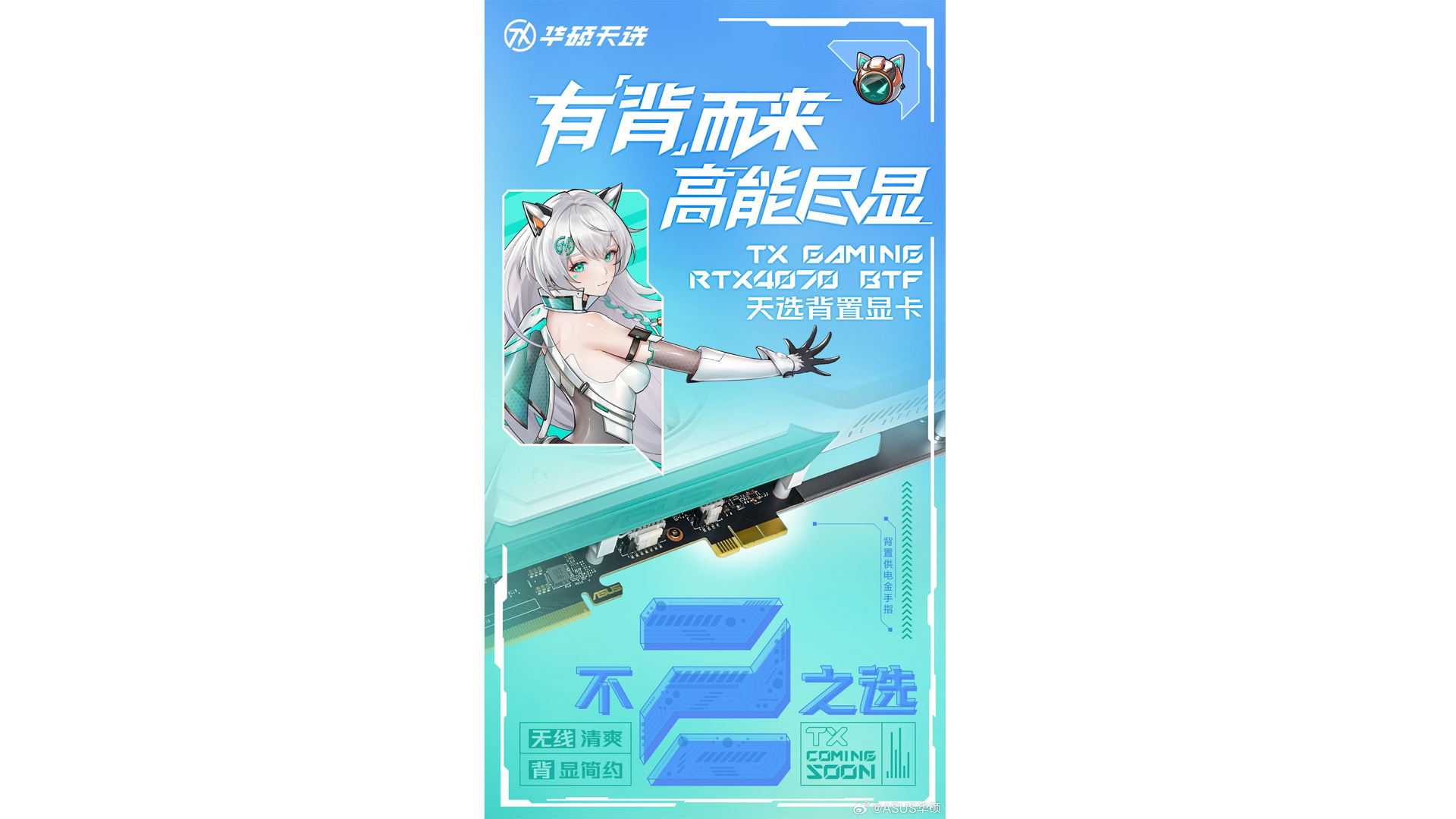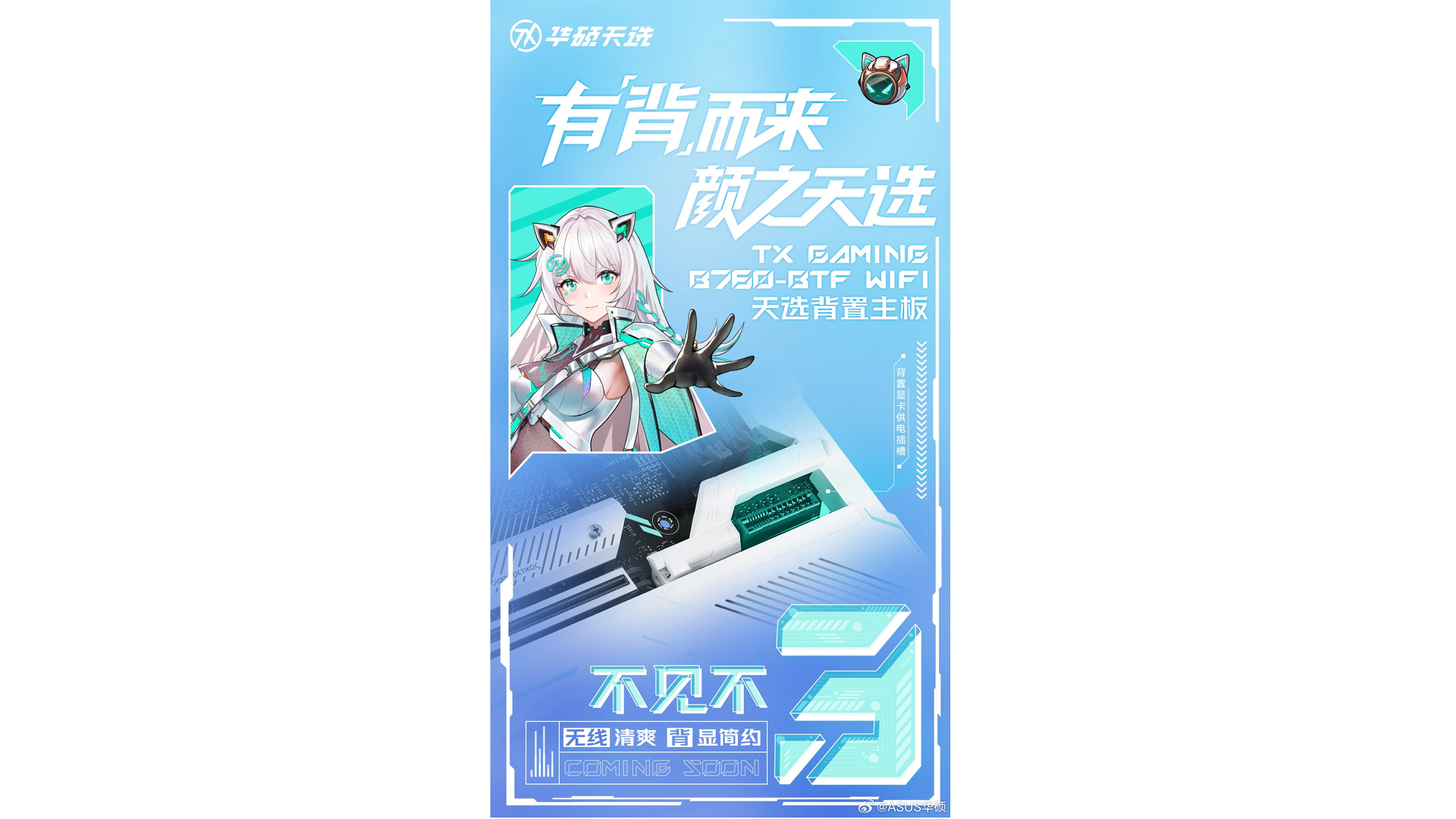Asus Launches First Cable-Less GPU, RTX 4070 BTF Debuts in Asia
Likely limited to Asia, though

Asus has announced a new RTX 4070 graphics card and a couple of B760 motherboards featuring hidden power connectors that will launch on Sept. 15, according to IT Home. The new products include the Tianxuan TX Gaming RTX 4070 graphics card, the first cable-less GPU to hit the market, and two new B760 motherboards. These new components will most likely be limited to the Asian market, at least for now.
We first learned the new GPUs were in production a few months ago. The new products take inspiration from Asus' new "Back-to-Future" (BTF) product stack that is designed to improve the aesthetic appeal of PC components by hiding or replacing all visible power connectors that might be present in a system. For motherboards, this includes redirecting the 24-pin and EPS power connectors to the rear of the PCB, allowing all power supply cables to be managed from the rear of the case alone.
For graphics cards, PCIe supplemental power connectors have been removed entirely in favor of a custom HPCE power connector that draws power straight from the motherboard itself. By extension, this also means that BTF-branded motherboards are equipped with the same connector, but not all boards will apparently support the HPCE connector specifically. For instance, Asus' TUF Gaming Z790 concept motherboard features the connector, but its B760M-BTF WIFI board does not.
Cases are also mixed into the BTF series, due to the fact that extra space behind the motherboard tray is required to exist so that power supply cables have enough room to be plugged into the rear power connectors on a BTF motherboard. For now, Asus has two BTF cases on its product page: the Asus A21 and the TUF Gaming GT502 Concept Case.
The Tianxuan TX Gaming B760-BTF WiFi motherboard and the Tianxuan RTX 4070 graphics card are anime-themed. The TUF Gaming B760M-BTF WiFi Shadowraider board features a black design, while the Tianxuan TX Gaming B760-BTF WiFi board comes in a white theme featuring cyan accents. Both boards offer 12+1 power delivery systems, and PCIe Gen 5 support.
The Tianxuan RTX 4070 takes on the same appearance as the TX board, featuring a white triple-fan cooling solution with cyan accents. Both B760 boards and the 4070 feature an HPCE power connector, allowing the RTX 4070 to draw power directly from the motherboard without a physical PCIe supplementary power cable. Asus also announced RTX 4060 Ti and RTX 4060 variants with the same triple-fan cooling solution, but these lower-end cards do not feature the HPCE power connector.
Since none of these Tianxuan-themed components are visible from Asus's US website, it appears these components will be exclusive to the Asian market. Pricing for the B760 motherboards is currently unknown, but the graphics cards will cost 5289 Yuan (~$728 USD) for the RTX 4070, 3789 Yuan (~$522 USD) for the RTX 4060 Ti, and 2789 Yuan (~$384 USD) for the RTX 4060.
Get Tom's Hardware's best news and in-depth reviews, straight to your inbox.

Aaron Klotz is a contributing writer for Tom’s Hardware, covering news related to computer hardware such as CPUs, and graphics cards.
-
ManDaddio Niche market. The people buying these are beta tester enthusiasts. 😏😆 The concept is welcomed for sure.Reply -
garrett040 I like the anime girl on the box, i hope manufactors go back to this style of putting characters on stuffReply -
eichwana What happens when your mobo dies and you can’t get a replacement that’s the same model? Does that mean your graphics card is also useless, since other models/brands don’t have the connector and the card doesn’t have standard power connectors?Reply -
Rakanyshu Reply
it wont be useless but i bet you would have to resort to pci-e cable riser and some kind of power adapter for the "new" interface. Not ideal thats why this kind of thing should be made a standard, same as every other pc component even the chain-linked pc fans and rgb controllers shoud be standardized.eichwana said:What happens when your mobo dies and you can’t get a replacement that’s the same model? Does that mean your graphics card is also useless, since other models/brands don’t have the connector and the card doesn’t have standard power connectors? -
ezst036 If that power connector is actually so superior and really the best thing going forward, then fine.Reply
Let's see them open source it and then donate it to the PCI-SIG. -
Kamen Rider Blade Reply
If the concept fails to gain traction, it's e-waste and another failed moment in Tech History.eichwana said:What happens when your mobo dies and you can’t get a replacement that’s the same model? Does that mean your graphics card is also useless, since other models/brands don’t have the connector and the card doesn’t have standard power connectors?
The HPCE connector would be better paired with a Open Standard version of MXM form factor that wasn't controlled by nVIDIAezst036 said:If that power connector is actually so superior and really the best thing going forward, then fine.
Let's see them open source it and then donate it to the PCI-SIG.
MXM-SIG that controls the MXM specification is a nVIDIA run group.
If we want modular PCIe cards that are "Open Standard" and part of PCI-SIG, we need to make a open version and add in HPCE connectors to it for Mobile.
I would want it to be paired with a standard MoBo form factor based off of Nano-ITX with slightly different screw holes placement.
Nano-ITX's MoBo spec of (12 cm by 12 cm) is perfect for most LapTop specs.
If we can get a common spec for LapTop's, that would be GREAT in avoiding all those proprietary main boards that are out there for each chasis.
It's time for the LapTop industry to start standardizing, having proprietary MoBo formats is horrible for the ever growing E-Waste problem that big vendors cause by using "Proprietary MoBo standards".
If the EU wants to do something about minimizing E-Waste in computing, regulate the big vendors like Dell, HP, Lenovo, into using standardized MoBo formats for their ENTIRE line-up.
wtaHNUmQ7Mk
Doesn't matter if it's DeskTop or LapTop, force a Standardized format that is similar to what DIY PC assembly has had for decades.
Proprietary should be BANNED and out-lawed. -
mwm2010 Reply
YES. Finally someone who gets it!Kamen Rider Blade said:If the concept fails to gain traction, it's e-waste and another failed moment in Tech History.
The HPCE connector would be better paired with a Open Standard version of MXM form factor that wasn't controlled by nVIDIA
MXM-SIG that controls the MXM specification is a nVIDIA run group.
If we want modular PCIe cards that are "Open Standard" and part of PCI-SIG, we need to make a open version and add in HPCE connectors to it for Mobile.
I would want it to be paired with a standard MoBo form factor based off of Nano-ITX with slightly different screw holes placement.
Nano-ITX's MoBo spec of (12 cm by 12 cm) is perfect for most LapTop specs.
If we can get a common spec for LapTop's, that would be GREAT in avoiding all those proprietary main boards that are out there for each chasis.
It's time for the LapTop industry to start standardizing, having proprietary MoBo formats is horrible for the ever growing E-Waste problem that big vendors cause by using "Proprietary MoBo standards".
If the EU wants to do something about minimizing E-Waste in computing, regulate the big vendors like Dell, HP, Lenovo, into using standardized MoBo formats for their ENTIRE line-up.
wtaHNUmQ7Mk
Doesn't matter if it's DeskTop or LapTop, force a Standardized format that is similar to what DIY PC assembly has had for decades.
Proprietary should be BANNED and out-lawed. -
Amdlova Another dumb connector :) graphics do coil whine now the motherboard will be a giant inductor... lolReply


